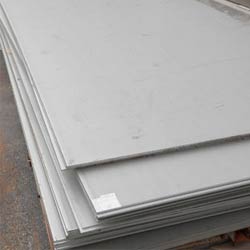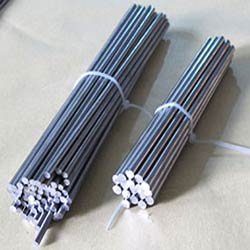Material Grade: R05200 is one of the common grades of pure tantalum, often referred to as unalloyed tantalum. It's known for its high melting point, corrosion resistance, and excellent conductivity.
Chemical Composition: Grade R05200 tantalum wire consists of tantalum as the primary element, typically with a purity of 99.95% or higher. The absence of alloying elements distinguishes it from other tantalum grades.
Applications: Tantalum wire in grade R05200 is used in various applications where its unique properties are beneficial. These include chemical processing, electronics (such as capacitors), aerospace components, medical devices, and high-temperature furnace parts.
Dimensional Specifications: Tantalum wire can be manufactured in different diameters, depending on the intended application. Common diameters range from fractions of a millimeter to several millimeters.
Properties:
Manufacturing: Tantalum wire is typically manufactured through processes such as drawing, extrusion, or rolling, depending on the desired dimensions and properties.
Availability: Grade R05200 tantalum wire is available from various manufacturers and suppliers specializing in tantalum products. It's important to ensure that the material meets the required specifications for your specific application.
Cost and Availability: The cost of tantalum wire can vary depending on factors such as purity, diameter, and market demand. Tantalum is generally considered a rare and valuable metal, which can influence its price and availability.

| Element | Composition (%) |
|---|---|
| Tantalum (Ta) | ≥ 99.95 |
| Nitrogen (N) | ≤ 0.010 |
| Carbon (C) | ≤ 0.010 |
| Oxygen (O) | ≤ 0.015 |
| Hydrogen (H) | ≤ 0.0015 |
| Iron (Fe) | ≤ 0.010 |
| Nickel (Ni) | ≤ 0.010 |
| Silicon (Si) | ≤ 0.005 |
| Titanium (Ti) | ≤ 0.0025 |
| Niobium (Nb) | ≤ 0.080 |
| Tungsten (W) | ≤ 0.050 |
Material Grade: Grade R05200 is a designation for pure tantalum, also known as unalloyed tantalum. It's distinguished by its high purity, typically 99.95% or higher.
Chemical Composition: Tantalum round bars in grade R05200 consist mainly of tantalum, with minimal impurities. The typical chemical composition is similar to that of tantalum wire:
| Element | Composition (%) |
|---|---|
| Tantalum (Ta) | ≥ 99.95 |
| Nitrogen (N) | ≤ 0.010 |
| Carbon (C) | ≤ 0.010 |
| Oxygen (O) | ≤ 0.015 |
| Hydrogen (H) | ≤ 0.0015 |
| Iron (Fe) | ≤ 0.010 |
| Nickel (Ni) | ≤ 0.010 |
| Silicon (Si) | ≤ 0.005 |
| Titanium (Ti) | ≤ 0.0025 |
| Niobium (Nb) | ≤ 0.080 |
| Tungsten (W) | ≤ 0.050 |
Applications: Tantalum round bars find applications in various industries where the exceptional properties of tantalum are required. These include chemical processing, electronics (particularly in capacitors), aerospace, medical implants, and high-temperature furnace components.
Properties:
Manufacturing: Tantalum round bars are typically manufactured through processes such as forging or extrusion. These processes help to achieve the desired dimensions and mechanical properties.
Availability: Tantalum round bars in grade R05200 are available from specialized tantalum suppliers and manufacturers. It's essential to ensure that the material meets the required specifications for your specific application.
Cost and Availability: Tantalum is considered a rare and valuable metal, which can influence its price and availability. The cost of tantalum round bars can vary depending on factors such as purity, dimensions, and market demand.

Material Grade: Grade R05200 is pure tantalum, often referred to as unalloyed tantalum. It's known for its high purity, typically 99.95% or higher.
Chemical Composition: Tantalum strips, sheets, and plates in grade R05200 have a chemical composition similar to other forms of pure tantalum, with minimal impurities. The typical composition includes:
| Element | Composition (%) |
|---|---|
| Tantalum (Ta) | ≥ 99.95 |
| Nitrogen (N) | ≤ 0.010 |
| Carbon (C) | ≤ 0.010 |
| Oxygen (O) | ≤ 0.015 |
| Hydrogen (H) | ≤ 0.0015 |
| Iron (Fe) | ≤ 0.010 |
| Nickel (Ni) | ≤ 0.010 |
| Silicon (Si) | ≤ 0.005 |
| Titanium (Ti) | ≤ 0.0025 |
| Niobium (Nb) | ≤ 0.080 |
| Tungsten (W) | ≤ 0.050 |
Forms: Tantalum is available in various forms including strips, sheets, and plates. Strips are typically thinner and narrower, sheets are larger and broader, while plates are thicker and often used for structural purposes.
Applications: Tantalum strips, sheets, and plates find applications in a wide range of industries due to tantalum's unique properties. These include:
Properties:
Manufacturing: Tantalum strips, sheets, and plates are typically manufactured through processes such as rolling, extrusion, or forging, depending on the desired dimensions and properties.
Availability and Cost: Tantalum strips, sheets, and plates in grade R05200 are available from specialized tantalum suppliers and manufacturers. The cost can vary depending on factors such as purity, dimensions, and market demand.

Material Grade: Grade R05200 refers to pure tantalum, also known as unalloyed tantalum. It's characterized by its high purity, typically 99.95% or higher.
Chemical Composition: Tantalum tubes and pipes in grade R05200 have a chemical composition similar to other forms of pure tantalum, with minimal impurities. The typical composition includes:
| Element | Composition (%) |
|---|---|
| Tantalum (Ta) | ≥ 99.95 |
| Nitrogen (N) | ≤ 0.010 |
| Carbon (C) | ≤ 0.010 |
| Oxygen (O) | ≤ 0.015 |
| Hydrogen (H) | ≤ 0.0015 |
| Iron (Fe) | ≤ 0.010 |
| Nickel (Ni) | ≤ 0.010 |
| Silicon (Si) | ≤ 0.005 |
| Titanium (Ti) | ≤ 0.0025 |
| Niobium (Nb) | ≤ 0.080 |
| Tungsten (W) | ≤ 0.050 |
Forms: Tantalum tubes and pipes are cylindrical hollow structures with different diameters and wall thicknesses, depending on the specific application requirements. They are often available in seamless or welded forms.
Applications: Tantalum tubes and pipes find applications in various industries due to tantalum's exceptional properties:
Properties:
Manufacturing: Tantalum tubes and pipes are typically manufactured through processes such as extrusion, forging, or rolling, followed by machining or welding for specific dimensional requirements.
Availability and Cost: Tantalum tubes and pipes in grade R05200 are available from specialized tantalum suppliers and manufacturers. The cost can vary depending on factors such as purity, dimensions, and market demand.

Material Grade: Grade R05200 refers to pure tantalum, also known as unalloyed tantalum. It's characterized by its high purity, typically 99.95% or higher.
Chemical Composition: Tantalum fittings in grade R05200 have a chemical composition similar to other forms of pure tantalum, with minimal impurities. The typical composition includes:
| Element | Composition (%) |
|---|---|
| Tantalum (Ta) | ≥ 99.95 |
| Nitrogen (N) | ≤ 0.010 |
| Carbon (C) | ≤ 0.010 |
| Oxygen (O) | ≤ 0.015 |
| Hydrogen (H) | ≤ 0.0015 |
| Iron (Fe) | ≤ 0.010 |
| Nickel (Ni) | ≤ 0.010 |
| Silicon (Si) | ≤ 0.005 |
| Titanium (Ti) | ≤ 0.0025 |
| Niobium (Nb) | ≤ 0.080 |
| Tungsten (W) | ≤ 0.050 |
Types of Fittings: Tantalum fittings come in various types to suit different piping and plumbing needs. These include but are not limited to:
Applications: Tantalum fittings are used in industries where resistance to corrosion, especially in aggressive environments, is crucial. Common applications include:
Properties:
Manufacturing: Tantalum fittings are typically manufactured using processes such as machining, forging, or casting, depending on the specific requirements of the fitting.
Availability and Cost: Tantalum fittings in grade R05200 are available from specialized tantalum suppliers and manufacturers. The cost can vary depending on factors such as purity, dimensions, and market demand.

Material Grade: Grade R05200 denotes pure tantalum, also known as unalloyed tantalum. It's characterized by its high purity, typically 99.95% or higher.
Chemical Composition: Tantalum flanges in grade R05200 have a chemical composition similar to other forms of pure tantalum, with minimal impurities. The typical composition includes:
| Element | Composition (%) |
|---|---|
| Tantalum (Ta) | ≥ 99.95 |
| Nitrogen (N) | ≤ 0.010 |
| Carbon (C) | ≤ 0.010 |
| Oxygen (O) | ≤ 0.015 |
| Hydrogen (H) | ≤ 0.0015 |
| Iron (Fe) | ≤ 0.010 |
| Nickel (Ni) | ≤ 0.010 |
| Silicon (Si) | ≤ 0.005 |
| Titanium (Ti) | ≤ 0.0025 |
| Niobium (Nb) | ≤ 0.080 |
| Tungsten (W) | ≤ 0.050 |
Types of Flanges: Tantalum flanges come in various types and configurations to suit different piping and plumbing needs. These include but are not limited to:
Applications: Tantalum flanges are used in industries where corrosion resistance and high-temperature stability are paramount. Common applications include:
Properties:
Manufacturing: Tantalum flanges are typically manufactured using processes such as machining, forging, or casting, depending on the specific requirements of the flange.
Availability and Cost: Tantalum flanges in grade R05200 are available from specialized tantalum suppliers and manufacturers. The cost can vary depending on factors such as purity, dimensions, and market demand.

Material Grade: Grade R05200 refers to pure tantalum, also known as unalloyed tantalum. It's characterized by its high purity, typically 99.95% or higher.
Chemical Composition: Tantalum welding rods in grade R05200 have a chemical composition similar to other forms of pure tantalum, with minimal impurities. The typical composition includes:
| Element | Composition (%) |
|---|---|
| Tantalum (Ta) | ≥ 99.95 |
| Nitrogen (N) | ≤ 0.010 |
| Carbon (C) | ≤ 0.010 |
| Oxygen (O) | ≤ 0.015 |
| Hydrogen (H) | ≤ 0.0015 |
| Iron (Fe) | ≤ 0.010 |
| Nickel (Ni) | ≤ 0.010 |
| Silicon (Si) | ≤ 0.005 |
| Titanium (Ti) | ≤ 0.0025 |
| Niobium (Nb) | ≤ 0.080 |
| Tungsten (W) | ≤ 0.050 |
Applications: Tantalum welding rods are primarily used in industries where tantalum's unique properties are required, including:
Properties:
Welding Process: Tantalum welding rods are typically used in processes such as gas tungsten arc welding (GTAW or TIG welding) or electron beam welding (EBW), depending on the specific requirements of the application.
Availability and Cost: Tantalum welding rods in grade R05200 are available from specialized tantalum suppliers and manufacturers. The cost can vary depending on factors such as purity, dimensions, and market demand.
